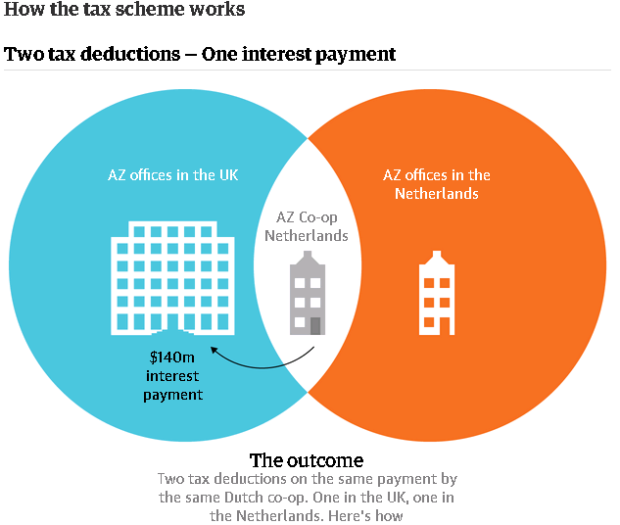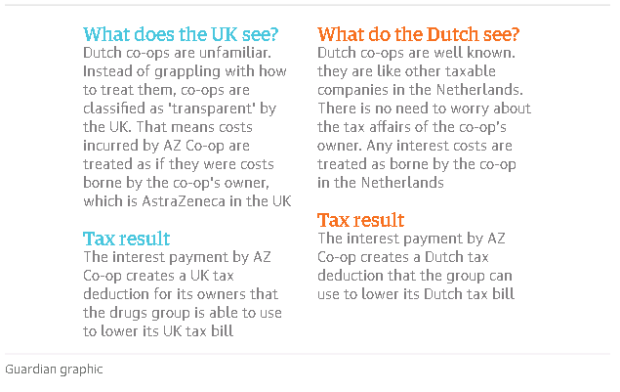Revealed: how AstraZeneca avoids paying UK corporation tax
Pharmaceuticals group defends use of legal avoidance scheme, after paying no UK corporation tax over two years despite global profits of £3bn
AstraZeneca, one of Britain’s largest businesses, is using a multimillion-pound tax avoidance scheme in the Netherlands, set up months after the UK relaxed its tax laws for multinationals in 2013.
A Guardian investigation has found the pharmaceutical giant created the scheme using $2.7bn (£1.8bn) of internal group loans routed through its Dutch subsidiaries.
The company paid no corporation tax in the UK, despite having made global profits in 2013 and 2014 totalling $4.5bn. It was legally able to do so partly by securing some UK tax deductions from the Dutch lending structure as well as by offsetting high running costs and investment at its UK operations and using other tax breaks, some relating to new medicine research and development.
Tax experts asked by the Guardian to review its findings said AstraZeneca’s scheme appeared to be constructed solely as a way to avoid tax, and that the company could benefit from this in the future.
But AstraZeneca said it has not made savings from the scheme and was winding up the Dutch structure ahead of an anticipated tightening of international tax rules by the OECD.
Stephen Shay, a senior law lecturer at Harvard Law School who has held senior tax roles in the US Treasury and who gave expert testimony in 2013 on Apple’s tax avoidance structures in a Senate investigation, said that it was “hard to say” how the companies in the Dutch structure “have a real commercial purpose other than to achieve the tax outcome”.
Each year in its annual report, AstraZeneca says: “We draw a distinction between tax planning using artificial structures and optimising tax treatment of business transactions and we engage only in the latter.”
AstraZeneca told the Guardian the promise stood. It conceded its Dutch arrangements involved some tax planning but said the main purpose was providing financing for overseas acquisitions. Any related tax matters had all been approved by HMRC and the Dutch tax office, it added.
Explaining its decision to pour $2.7bn of loans through a Dutch structure, it said: “AstraZeneca acted on the UK legislation introduced … to give companies greater freedom in managing overseas financing operations…
“The use of this UK government-sponsored regime for tax planning purposes did not produce any tax savings for AstraZeneca. In 2013 and 2014, the AstraZeneca UK group of companies was not profitable due to patent expirations and continued investment in the research and development of new medicines.”
Independent experts said it was hard to reach a final assessment of the value of tax advantages from the Dutch avoidance structure because this depended on AstraZeneca’s future ability to make use of certain tax credits it now held. “It’s not as though [AstraZeneca] is not going to get a benefit,” said Shay. “It’s only a question of the value of the benefit on a present-value basis. You can’t say Astra doesn’t have a benefit.”
AstraZeneca’s Dutch structure was set up less than five months after new rules came into effect reining in HMRC powers to combat tax avoidance by international businesses.
Richard Brooks, a former HMRC tax inspector, now a journalist at Private Eye and author of The Great Tax Robbery, said: “It’s clear from the AstraZeneca companies’ accounts and replies to [the Guardian] that this scheme was designed to generate a UK tax advantage.”
Richard Murphy, accountant, tax campaigner and the author of The Joy of Tax, said: “The structure only appears to exist for tax purposes, to try to secure a tax advantage.”
AstraZeneca’s top tax accountant, Ian Brimicombe, sat for several years on a Treasury committee advising the government on the changes in the law. Without one alteration, which came into force almost three years ago, the group’s avoidance structure would not have worked.
Osborne is expected to use a speech to the Conservative party conference in Manchester on Monday morning to highlight how the UK economy is reaping benefits from the highly competitive tax regime he created.
Hours later, in Paris, much-anticipated international tax reform proposals by the Organisation for Economic Cooperation and Development (OECD) targeting tax avoidance by multinationals will be published.
Senior OECD officials have warned current rules are so abused – both by multinationals and by countries competing for investment – that they are close to breaking point.
But British diplomats, while supportive of many OECD reforms, have battled behind the scenes to to protect prized tax policies that helped make Britain a favourable environment for the location of international business.
Pascal Soriot, AstraZeneca’s chief executive, was among more than 100 business leaders who signed an open letter in support of Conservative party tax policies during the general election campaign earlier this year. Soriot later said he had not intended to endorse a political party but confirmed: “I support policies that reinforce a competitive tax environment and encourage investment in the UK.”
In April 2013 AstraZeneca set up its unusual Dutch lending operation – an arrangement described as “highly artificial tax avoidance” by independent tax experts.
The loan structure, which is within the law, centred around a type of Dutch co-operative, an unusual corporate entity first allowed in the mid-19th century to assist dairy farmers.
AstraZeneca’s co-operative is incorporated at the group’s Dutch offices, eight miles east of The Hague. Accounts for AstraZeneca Finance Coöperatief WA do not show signs of significant business activity: there are no staff on the payroll and it has modest operating costs.
Nevertheless the co-operative was packed with loans of $2.7bn from head office in the UK, and charged interest of more than $140m a year.
Interest flows exploited differences between the way tax codes in the UK and the Netherlands apply to Dutch co-operatives. The result was that the two tax offices treated the interest as occurring on their own patch, both awarding huge tax breaks for the same payment.
In tax avoidance jargon, claiming a tax deduction twice on the same payment is called “double dipping”.
Brooks said: “Generating a double tax deduction for a single expense by using a strange Dutch entity that one tax authority sees one way, and another as something completely different, looks like highly artificial tax avoidance.”
Under previous versions of HMRC’s anti-avoidance laws – known as the controlled foreign companies (CFC) regime – the tax benefit of a double dip could be pounced on by HMRC and neutralised. Since tax office powers were reduced, however, only about a quarter of the tax advantage can be clawed back.





